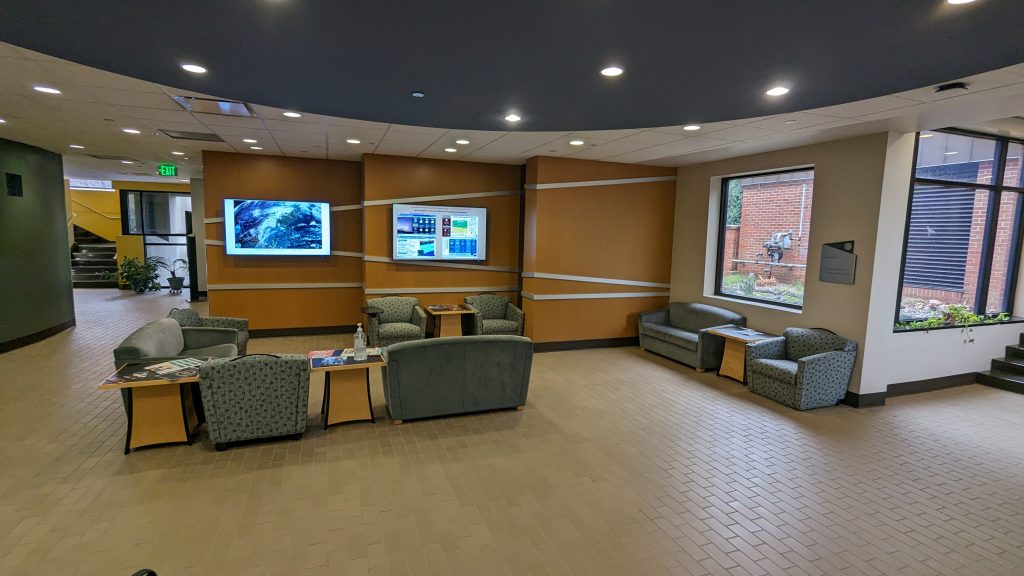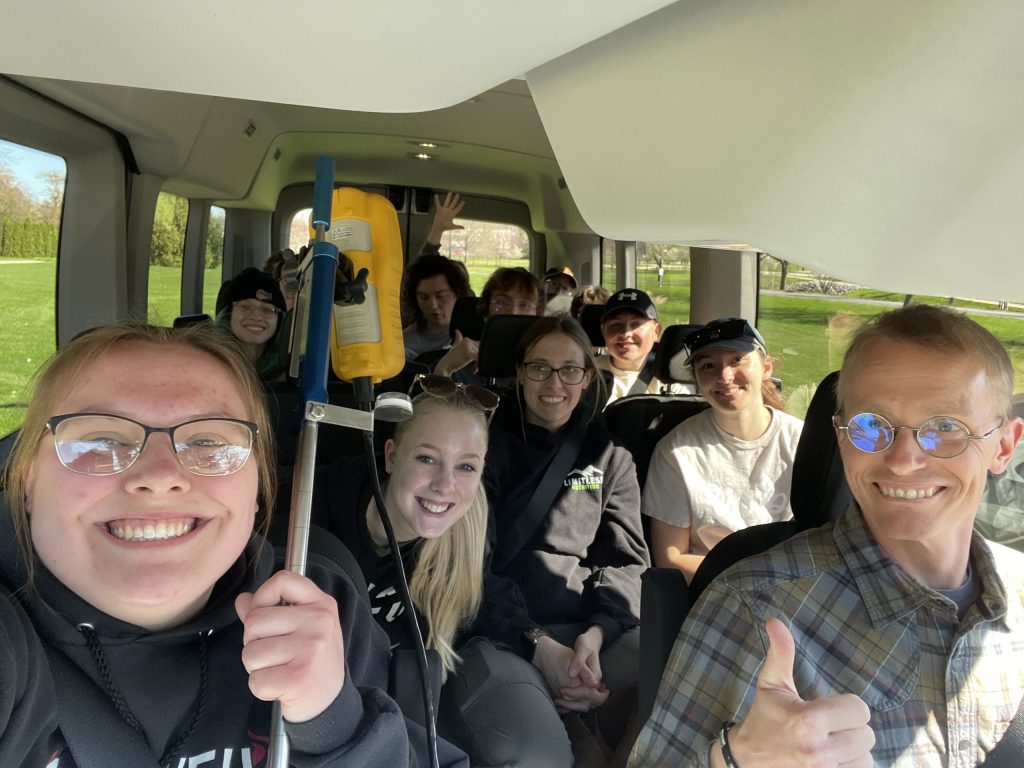Facilities
Digital tools that help map and analyze geographic and atmospheric data, weather balloons, Doppler radar, storm-chasing vehicle and equipment: the resources available to students of geography and meteorology at Valpo are superb.
Classroom technologies help students visualize and understand important concepts, and students’ access to sophisticated field and laboratory equipment is extraordinary. Thanks to plenty of hands-on experience, graduates of Valpo’s geography and meteorology programs are prepared to apply their knowledge.

The department’s home is in Kallay-Christopher Hall, an award-winning facility that signals its connection to the weather and the world around it with its strikingly angled wall of windows. It is connected by a glass walkway to Schnabel Hall, which houses a geographic applications lab as well as television and digital media studios used by students exploring a career in broadcast meteorology.
Meteorology Facilities
The Bart J. Wolf Weather Center
In this high-tech laboratory, students gain hands-on experience and provide weather information and forecasts for Northwest Indiana. An open space surrounded by floor-to-ceiling glass windows, the Center offers individual work space as well as areas suited for group work and discussion. The spectacular views are enhanced by an impressive array of meteorological equipment, including the following:
- 20 dual-monitor computer work stations using Linux OS
- Live data from a 33-foot (10-meter) instrumented mesonet tower
- UNIDATA and GEMPAK data retrieval and display systems
- Live data feed from Valpo’s dual-polarization Doppler radar
- Kestrel hand-held sensors for field projects
Doppler Radar (Undergoing Maintenance)
1 MW 5-cm (C-band) simultaneous dual-polarization Doppler radar, located on the west side of campus, is used for student research and coursework.
Weather Observation Deck
The weather observation deck, adjacent to the weather center and meteorology classrooms, offers an unobstructed view of the southern and western horizon. From the observation deck and the windows in the Weather Center, it is possible to observe all 360 degrees of the sky from the second floor of Kallay-Christopher Hall. The Radiosonde Launcher is also located on the weather observation deck.
Radiosonde System
Portable and fixed InterMet Radiosonde systems track weather balloon radiosondes and retrieve the atmospheric data in real time. Students launch weather balloons from the Radiosonde Launcher, from the weather observation deck, and in the field. Used for coursework and student research, the sounding data can be found on the Valpo Meteorology Online Weather Center.
Radiosonde Launcher
An automated radiosonde launcher automatically inflates weather balloons and launches instrument packages from the weather observation deck.
Storm-Chase Vehicle
A Dodge Ram crew cab pickup, used during summer storm chases, is outfitted with a variety of instrumentation during field studies. iPads provided through a generous GoFundMe initiative also provide each vehicle in the convective summer field study with a mobile computer platform.
Total Sky Imager (Undergoing Maintenance)
Located on the roof of Kallay-Christopher Hall, the Yankee Environmental Services Total Sky Imager takes pictures of the entire sky that can be used to measure cloud cover.
Weather TV Studio
Located in nearby Schnabel Hall and connected to Kallay-Christopher Hall by a glass walkway, the Weather Studio outfitted with WSI TruVu software emulates the environment of many professional broadcast studios. The Weather Studio gives meteorology students the opportunity to learn the technical aspects as well as the art of TV weather broadcasting.
Geography and GIS Facilities
F.P. Kallay Geographic Applications Laboratory
This facility, outfitted with more than 20 Windows desktop computers, provides access to powerful GIS, cartography, and remote sensing software including ArcGIS, ENVI, MultiSpec, QGIS, and Adobe Creative Suite. Located in Schnabel 34, it is open to all geography, meteorology, and environmental science majors and minors.
DJI Mavic 3 Multispectral (Drone)
This drone allows us not only to engage in high-resolution aerial mapping, but the imagery extending into the near infrared allows us to easily determine vegetation health as well as other remote sensing spectral-based analyses. Students who obtain a remote pilot certificate from the FAA can fly the drone during various courses and field projects.
15 Passenger Van
Our department van enables us free regional travel for fieldwork and courses like the 5-day Process Geomorphology Trip, where students explore caves and other geographical features during Fall Break. The van also allows for easy travel to conferences and events for student engagement in the profession.
Christopher Center Map Collection
The map collection located on the first floor of the Christopher Center includes maps from the U.S. Geological Survey, National Geospatial-Intelligence Agency, CIA, and Departments of Agriculture and Interior. The collection also contains National Geographic maps and maps of cities in Indiana, the United States, and the world.
Departmental Map Collection
Located in the map cabinets in the downstairs lab, the departmental map collection includes selected USGS topographic maps for all 50 states.
Geographic Data Collection Instrumentation
Tools of the trade for geography field work, students benefit from a variety of instrumentation, including:
- Horiba Particle Analyzer
- Fluxgate Gradiometers
- Trimble GeoXM GPS portable unit and field antenna
- Trimble Juno GPS handheld units
- Garmin GPSMAP 62st handheld units
- DeLorme Earthmate PN-60 handheld units
- GarminMap 76S handheld units
Physical Geography Lab »

Selfie of students and faculty in the department van 
Students learn to operate the department’s drone 
Shallow groundwater wells and sensors to track water table fluctuations across a landscape 
Students connect fieldwork with results by studying physical earth and environmental processes in the physical geography lab 
Students transported by the department van to conduct fieldwork 
Students prepare for drone flight
Classrooms and Community Spaces
Classrooms
State-of-the-art classrooms in Kallay-Christopher Hall include a 60-seat tiered classroom, a small classroom with moveable seats designed to facilitate discussion, and two laboratory classrooms. All classrooms offer full multimedia capabilities and Internet access. Laboratory classrooms feature restored historic map cabinets.
Student Study Area
An area adjacent to the Weather Center on the second floor of Kallay-Christopher Hall provides a welcoming environment for students, featuring a wall-sized map of the world, a white board for study review and a mobile VisBox wall-sized monitor for dynamic display of weather maps.
Lobby Study Area
The first floor lobby of Kallay-Christopher Hall provides a pleasant meeting and study space for students and visitors, with café tables for a quick lunch or study space, comfortable chairs and couch for a group discussion area, and real-time weather and model data updated on wall-mounted monitors. Around the corner at the northeast entrance, a GeoChron tracks the global daylight coverage through the year.
Conference Room
Located on the first floor of Kallay-Christopher Hall, the conference room is perfect for small class discussions, department meetings, student executive board sessions, and quiet study.






